Creating Great REST and gRPC API Experiences (in Swift)
- 1. Creating Great REST and gRPC API Experiences (in Swift) Tim Burks Google
- 2. October 4, 2000 CL 23852 by jeff ProtocolBuffer, a class for encoding hierarchical data in a compact binary form... Co-designed and Rev. by Sanjay
- 10. 10 billion+ API calls every second
- 11. Protocol Buffers a language-neutral, platform-neutral, extensible mechanism for serializing structured data.
- 12. “Protocol Buffers” means several things 1. A serialization mechanism 2. An interface description language 3. A methodology
- 13. A Serialization Mechanism An encoded message is just a stream of bytes [field_number<<3 + wire_type] [length if necessary] [data]... $ hexdump /tmp/request.bin 0000000 0a 05 68 65 6c 6c 6f 0a is “0000 1010”, so field_number = 1 and wire_type = 2
- 14. An Interface Definition Language syntax = "proto3"; package echo; // The message used for echo requests and responses. message EchoMessage { string text = 1; }
- 15. A Methodology % protoc echo.proto --swift_out=. # This runs a plugin called protoc-gen-swift # # The plugin generates a Swift source file that implements # the data structures defined in models.proto and code # for reading and writing them as serialized bytes.
- 16. echo.pb.swift // DO NOT EDIT. // // Generated by the Swift generator plugin for the protocol buffer compiler. // Source: echo.proto // // For information on using the generated types, please see the documenation: // https://github.com/apple/swift-protobuf/ ... /// The message used for echo requests and responses. struct Echo_EchoMessage { // SwiftProtobuf.Message conformance is added in an extension below. See the // `Message` and `Message+*Additions` files in the SwiftProtobuf library for // methods supported on all messages. var text: String = String() var unknownFields = SwiftProtobuf.UnknownStorage() init() {} } // MARK: - Code below here is support for the SwiftProtobuf runtime.
- 17. A Data Definition Language syntax = "proto3"; package models; message User { string id = 1; string name = 2; repeated PlantList plantLists = 3; } message PlantList { string id = 1; string name = 2; repeated PlantListItem plants = 11; } message PlantListItem { string id = 1; string botanical_name = 2; }
- 18. Protocol Buffers aren’t just for networking class UserData { static let sharedInstance = UserData() public var user : Models_User init() { // read info from UserDefaults if let userdata = UserDefaults.standard.data(forKey:"user") { do { user = try Models_User(serializedData:userdata) } catch { user = Models_User() } } else { user = Models_User() } } func save() { DispatchQueue.main.async { do { try UserDefaults.standard.set(self.user.serializedData(), forKey:"user") } catch (let error) { print("SAVE ERROR (error)") } } }
- 19. Interface Builder for Data message Person { string name = 1; int32 id = 2; string email = 3; message PhoneNumber { string number = 1; } repeated PhoneNumber phone = 4; } Interface Builder: Developers specify their interfaces using a special tool, tooling compiles and integrates that into their apps. Protocol Buffers: Developers specify their data structures using a special language, tooling compiles and integrates that into their apps.
- 20. Let’s talk about Networked APIs From the Google Cloud APIs Design Guide: “Application Programming Interfaces that operate across a network of computers. They communicate using network protocols including HTTP, and are frequently produced by different organizations than the ones that consume them.”
- 21. API Styles 1. Remote Procedure Call (RPC) 2. Representational State Transfer (REST)
- 22. An RPC is just a function call. service Echo { // Immediately returns an echo of a request. rpc Get(EchoRequest) returns (EchoResponse) {} }
- 23. What is a REST API? From the Richardson Maturity Model (as described by Martin Fowler): Level 3 Hypermedia Controls Level 2 HTTP Verbs Level 1 Resources Level 0 HTTP
- 24. Hypermedia Controls??? HATEOAS (Hypertext As The Engine Of Application State) <appointment> <slot id = "1234" doctor = "mjones" start = "1400" end = "1450"/> <patient id = "jsmith"/> <link rel = "/linkrels/appointment/cancel" uri = "/slots/1234/appointment"/> <link rel = "/linkrels/appointment/addTest" uri = "/slots/1234/appointment/tests"/> <link rel = "self" uri = "/slots/1234/appointment"/> <link rel = "/linkrels/appointment/changeTime" uri = "/doctors/mjones/slots?date=20100104@status=open"/> <link rel = "/linkrels/appointment/updateContactInfo" uri = "/patients/jsmith/contactInfo"/> <link rel = "/linkrels/help" uri = "/help/appointment"/> </appointment> (source: Martin Fowler)
- 25. REST Requirements - Roy Fielding ● A REST API should not be dependent on any single communication protocol. ● A REST API should not contain any changes to the communication protocols aside from filling-out or fixing the details of underspecified bits of standard protocols. ● A REST API should spend almost all of its descriptive effort in defining the media type(s) used for representing resources and driving application state, or in defining extended relation names and/or hypertext-enabled markup for existing standard media types. ● A REST API must not define fixed resource names or hierarchies (an obvious coupling of client and server). ● A REST API should never have “typed” resources that are significant to the client. ● A REST API should be entered with no prior knowledge beyond the initial URI (bookmark) and set of standardized media types that are appropriate for the intended audience (i.e., expected to be understood by any client that might use the API).
- 26. 1. HTTP/HTTPS a. Paths describe resources (nouns) b. HTTP verbs describe actions 2. JSON Payloads REST in Practice
- 27. OpenAPI Industry standard format for describing for REST APIs Originally designed for documentation, now with many other applications: API Authoring, Validation, Documentation, Analysis, Search, Testing, Mocking, Management, Code Generation
- 28. 2010-11: Google API Discovery Format
- 29. Discovery Format Code Generators
- 34. Authorization: How do we tell an API server that it’s ok to respond to our requests? We need to provide a token: var request = URLRequest(url:url) request.httpMethod = method request.httpBody = ... // add any needed request headers request.setValue(authorization, forHTTPHeaderField:"Authorization") How do we get that?
- 35. OAuth2 Authorization Flow For an implementation in Swift, see BrowserTokenProvider.swift Client Service Authorization URL Sign-In Page (HTML) Human Confirmation Browser Redirect w/ Code Token Request (Code) Token Web Browser
- 36. Easier ways to get tokens (1 of 2) If you’re running inside a VM on Google Cloud Platform, you can get a token from the Google Cloud Metadata Service. % curl http://metadata/computeMetadata/v1/instance/service-accounts/default/token {"access_token":"ya29.GqUBUgXcBmIt7vfHsWJT4qVzdhWxwEb2f3tamcA6ykrIsEANZfQnoH0HDCBnlCztLw cD47w7YENghIucNUIIypLId4C5dXc4H8D93e17MrSbGRe4ipfoQhxPCIhIU3KJsvFjel0HcN2iwf8xURv2z1lWiN 2jkZjzLiMRWPKfSvtBVzuWkIo5uZ5u25IXle3tJ4SICh0-516sU84DFu0wkPO-q1xGpiff","expires_in":179 9,"token_type":"Bearer"} Then pass “Bearer “ + access_token as the Authorization header. See GoogleCloudMetadataTokenProvider.swift.
- 37. Easier ways to get tokens (2 of 2) If you’re calling a Google API from anywhere, you can use a Service Account. 1. Create and download the account credentials. 2. Create a JWT and sign it with the account credentials. 3. POST the signed JWT to the Google Account Service and get a token! See ServiceAccountTokenProvider.swift.
- 38. Aside: Build an HTTP server with swift-server/http
- 39. ● REST APIs ○ Discovery Format ○ 250+API descriptions ○ 10+ generators ● gRPC APIs ○ Protocol Buffer Language ○ 40+ gRPC-based APIs ○ 7+ target languages
- 40. gRPC Open-Source messaging system based on Google’s internal API architecture. Used for code and documentation generation, API management, and support services for APIs and microservices running at very large scale.
- 41. gRPC is owned by the Cloud Native Computing Foundation
- 42. gRPC Adoption Microservices: in data centres Streaming telemetry from network devices Client Server communication/Internal APIs Mobile Apps
- 43. gRPC Transport Mechanism Client → Server Server → Client Initial Metadata MsgMsg End of Stream Status & Trailing Metadata Initial Metadata MsgMsg Msg HTTP/2
- 47. Build a Swift client and service with gRPC https://github.com/grpc/gr pc-swift/wiki/Try-gRPC-Swi ft-in-a-Google-Compute-Eng ine-VM or just https://goo.gl/ux4Txh
- 48. echo.proto package echo; service Echo { // Immediately returns an echo of a request. rpc Get(EchoRequest) returns (EchoResponse) {} // Splits a request into words and returns each word in a stream of messages. rpc Expand(EchoRequest) returns (stream EchoResponse) {} // Collects a stream of messages and returns them concatenated when the caller closes. rpc Collect(stream EchoRequest) returns (EchoResponse) {} // Streams back messages as they are received in an input stream. rpc Update(stream EchoRequest) returns (stream EchoResponse) {} } message EchoRequest { // The text of a message to be echoed. string text = 1; } message EchoResponse { // The text of an echo response. string text = 1; }
- 49. main.swift (1/3) // Unary if client == "get" { var requestMessage = Echo_EchoRequest() requestMessage.text = message print("Sending: " + requestMessage.text) let responseMessage = try service.get(requestMessage) print("get received: " + responseMessage.text) } // Server streaming if client == "expand" { var requestMessage = Echo_EchoRequest() requestMessage.text = message print("Sending: " + requestMessage.text) let expandCall = try service.expand(requestMessage) {result in } var running = true while running { do { let responseMessage = try expandCall.receive() print("Received: (responseMessage.text)") } catch Echo_EchoClientError.endOfStream { print("expand closed") running = false } } }
- 50. main.swift (2/3) // Client streaming if client == "collect" { let collectCall = try service.collect() {result in } let parts = message.components(separatedBy:" ") for part in parts { var requestMessage = Echo_EchoRequest() requestMessage.text = part print("Sending: " + part) try collectCall.send(requestMessage) {error in print(error)} sleep(1) } let responseMessage = try collectCall.closeAndReceive() print("Received: (responseMessage.text)") }
- 51. main.swift (3/3) // Bidirectional streaming if client == "update" { let updateCall = try service.update() {result in} DispatchQueue.global().async { var running = true while running { do { let responseMessage = try updateCall.receive() print("Received: (responseMessage.text)") } catch Echo_EchoClientError.endOfStream { print("update closed") latch.signal() break } catch (let error) { print("error: (error)") } } } ... ... let parts = message.components(separatedBy:" ") for part in parts { var requestMessage = Echo_EchoRequest() requestMessage.text = part print("Sending: " + requestMessage.text) try updateCall.send(requestMessage) {error in print(error)} sleep(1) } try updateCall.closeSend() // Wait for the call to complete. latch.wait() } }
- 52. EchoService.swift (1/3) class EchoProvider : Echo_EchoProvider { // get returns requests as they were received. func get(request : Echo_EchoRequest, session : Echo_EchoGetSession) throws -> Echo_EchoResponse { var response = Echo_EchoResponse() response.text = "Swift echo get: " + request.text return response } // expand splits a request into words and returns each word in a separate message. func expand(request : Echo_EchoRequest, session : Echo_EchoExpandSession) throws -> Void { let parts = request.text.components(separatedBy: " ") var i = 0 for part in parts { var response = Echo_EchoResponse() response.text = "Swift echo expand ((i)): (part)" try session.send(response) i += 1 sleep(1) } }
- 53. EchoService.swift (2/3) // collect collects a sequence of messages and returns them concatenated when the caller closes. func collect(session : Echo_EchoCollectSession) throws -> Void { var parts : [String] = [] while true { do { let request = try session.receive() parts.append(request.text) } catch Echo_EchoServerError.endOfStream { break } catch (let error) { print("(error)") } } var response = Echo_EchoResponse() response.text = "Swift echo collect: " + parts.joined(separator: " ") try session.sendAndClose(response) }
- 54. EchoService.swift (3/3) // update streams back messages as they are received in an input stream. func update(session : Echo_EchoUpdateSession) throws -> Void { var count = 0 while true { do { let request = try session.receive() count += 1 var response = Echo_EchoResponse() response.text = "Swift echo update ((count)): (request.text)" try session.send(response) } catch Echo_EchoServerError.endOfStream { break } catch (let error) { print("(error)") } } try session.close() } }
- 55. Why generate client libraries for APIs? Make it easier to use Google APIs. ● Hide implementation details from API consumers. ● Develop API clients faster. ● Improve API client quality. ○ Better performance ○ Better consistency ○ Fewer bugs
- 57. GAPIC Customers Google Cloud APIs Google Ads APIs …other Google teams …external API producers?
- 58. GAPIC Features and Benefits ● Usability: ○ Trivial getting-started experience ○ Flattening ○ Natural paging ○ Long-running operations ○ Sample code for every method ○ Resource name types (e.g. for /projects/{project}/topics/{topic}) ● Performance: ○ Batching ● Reliability: ○ Automatic retries
- 59. Trivial Getting-Started Experience GAPIC client: Channel channel = NettyChannelBuilder.forAddress(API_ENTRY, API_PORT).build(); List<ClientInterceptor> interceptors = new ArrayList<>(); GoogleCredentials credentials = GoogleCredentials.getApplicationDefault(); interceptors.add( ChannelFactory.credentialInterceptor(credentials)); LoggingService stub = LoggingServiceGrpc.newBlockingStub(channel, interceptors); gRPC: LoggingClient client = LoggingClient.create();
- 60. Automatic Retry and Flattening GAPIC client: LoggingService stub = ...; // Note: this only does a simple retry, exponential backoff // is more complex DeleteLogRequest request = DeleteLogRequest.newBuilder() .setLogName(LOG_NAME) .build(); for (int i = 0; i < MAX_RETRY; i++) { try { stub.deleteLog(request); } catch (RpcException e) { if (i == MAX_RETRY) throw e; } } gRPC: LoggingClient client = LoggingClient.create(); client.deleteLog(LOG_NAME);
- 61. Natural Pagination GAPIC client: LoggingService stub = ...; ListLogsRequest request = ListLogsRequest.newBuilder() .setParentName("projects/" + PROJECT_ID) .build(); while (true) { ListLogsResponse response = stub.listLogs(request); for (Log log : response.getLogsList()) { System.out.printf("Log: %s%n", log.getDisplayName()); } String nextPageToken = response.getNextPageToken(); if (nextPageToken != null) { request = ListLogsRequest.newBuilder() .setPageToken(nextPageToken).build(); } else { break; } } gRPC: LoggingClient client = LoggingClient.create(); ParentNameOneOf parent = ParentNameOneOf.from(ProjectName.create(PROJECT_ID)); for (Log log : client.listLogs(PARENT).iterateAll()) { System.out.printf("Log: %s%n", log.getDisplayName()); }
- 62. Long-Running Operations SpeechClient speechClient = SpeechClient.create(); OperationFuture<LongRunningRecognizeResponse> recognizeOperation = speechClient.longRunningRecognizeAsync(config, audio); … LongRunningRecognizeResponse response = recognizeOperation.get(); ● Java: OperationFuture ○ Polls the service until the LRO is done ○ Provides metadata as the LRO is in progress ○ Provides the final result
- 63. Resource Name Types GAPIC client: PublisherService stub = ...; CreateTopicRequest request = CreateTopicRequest.newBuilder() .setTopic("projects/my-project/topics/my-topic") .build(); Topic response = stub.createTopic(request); gRPC: TopicAdminClient topicAdminClient = TopicAdminClient.create(); TopicName name = TopicName.create("my-project", "my-topic"); Topic response = topicAdminClient.createTopic(name);
- 65. GAPIC Project Architecture (hosted at github.com/googleapis) gapic-generator-python WANTED: ruby, swift, rust, elixir... gapic-generator (java, php, python, go, csharp, node, ruby) gapic-generator-kotlin gapic-generator-go gapic-generator-csharp gapic-generator-typescript One API description (Annotated .proto files) Many language- specific client libraries
- 66. Standard (Language-Independent) API Client Configuration
- 68. What can else we get from an API description format? ● Generated CLIs ● Generated Documentation ● API review and governance ● API management services ● Server frameworks and tools ● Generated mock servers ● Automatic testing ● API search and discovery
- 69. Manage Your Service With Endpoints Develop, deploy and manage APIs on any Google Cloud Platform backend. ● User Authentication via JSON Web Token validation ● Logging and Monitoring ● API Keys ● Easy integration + deployment
- 70. Endpoints Architecture GCE, GKE, Kubernetes or App Engine Flexible Environment Instance GCE, GKE, Kubernetes or App Engine Flexible Environment Instance (or off-GCP) Extensible Service Proxy Container API Container Google Service Management API User Code api calls gcloud Config deployment Google Cloud Console Google Service Control API config Runtime check & report Load balanci ng Stackdriver Metrics & logs Metrics & logs visualized
- 71. Generate FileDescriptorSet protoc kiosk.proto -I api-common-protos -I . --include_imports --include_source_info --descriptor_set_out=generated/kiosk_descriptor.pb --go_out=plugins=grpc:generated
- 72. Describing the Service type: google.api.Service config_version: 3 name: my-api.endpoints.my-gcp-project.cloud.goog title: Kiosk gRPC API apis: - name: kiosk.Display
- 73. Starting Endpoints Proxy in Front of Application gcloud endpoints services deploy service.yaml kiosk_descriptor.pb ./endpoints/START_ENDPOINTS_PROXY.sh my-gcp-project my-api <keyfile>
- 74. $ export KIOSK_PORT=8083 $ k list kiosks FROM localhost:8083 LIST KIOSKS rpc error: code = Unauthenticated desc = Method doesn't allow unregistered callers (callers without established identity). Please use API Key or other form of API consumer identity to call this API. Starting Endpoints Proxy in Front of Application
- 75. $ export KIOSK_APIKEY=AIzaSy[...]bBo $ k list kiosks FROM localhost:8083 2018/09/21 19:08:25 Using API key: AIzaSy[...]bBo LIST KIOSKS id:1 name:"HTTP Kiosk" size:<width:1080 height:720 > id:2 name:"HTTP Kiosk" size:<width:1080 height:720 > Getting an API Key
- 76. Build a gRPC service, get a free REST API!
- 77. service Display { rpc CreateKiosk(Kiosk) returns (Kiosk) { option (google.api.http) = {post:"/v1/kiosks"}; } rpc GetKiosk(GetKioskRequest) returns (Kiosk) { option (google.api.http) = {get: "/v1/kiosks/{id}" }; } rpc DeleteKiosk(DeleteKioskRequest) returns (google.protobuf.Empty) { option (google.api.http) = { delete: "/v1/signs/{id}" }; } [...] } Add REST annotations to your service gRPC definitions with HTTP annotations service Display { rpc CreateKiosk(Kiosk) returns (Kiosk) { } rpc GetKiosk(GetKioskRequest) returns(Kiosk) { } rpc DeleteKiosk(DeleteKioskRequest) returns (google.protobuf.Empty) { } [...] } gRPC definitions
- 78. # Add a kiosk $ curl -d '{"name":"HTTP Kiosk", "size": { width: 1080, height: 720 } }' localhost:8082/v1/kiosks?key=AIzaSy[...]bBo # Get kiosk $ curl localhost:8082/v1/kiosks/1?key=AIzaSy[...]bBo Now you can use HTTP+JSON!
- 79. Use Endpoints, get a free developer portal!
- 80. Build GraphQL interfaces to gRPC services with rejoiner
- 81. BONUS: Call Google RPC APIs with HTTP/1 using gRPC Fallback
- 82. We’re in the Summer of Code!
- 83. Have a Slice of APIs with us!
- 84. And don’t miss: Swift for Tensorflow













![A Serialization Mechanism
An encoded message is just a stream of bytes
[field_number<<3 + wire_type] [length if necessary] [data]...
$ hexdump /tmp/request.bin
0000000 0a 05 68 65 6c 6c 6f
0a is “0000 1010”, so
field_number = 1 and wire_type = 2](https://image.slidesharecdn.com/creatinggreatrestandgrpcapiexperiencesinswift-190330042808/85/Creating-Great-REST-and-gRPC-API-Experiences-in-Swift-13-320.jpg)
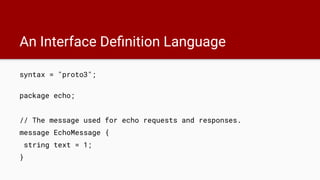



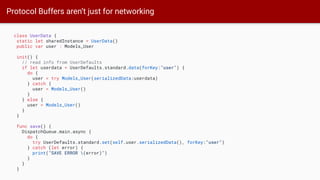






























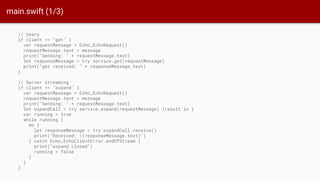



![EchoService.swift (2/3)
// collect collects a sequence of messages and returns them concatenated when the caller closes.
func collect(session : Echo_EchoCollectSession) throws -> Void {
var parts : [String] = []
while true {
do {
let request = try session.receive()
parts.append(request.text)
} catch Echo_EchoServerError.endOfStream {
break
} catch (let error) {
print("(error)")
}
}
var response = Echo_EchoResponse()
response.text = "Swift echo collect: " + parts.joined(separator: " ")
try session.sendAndClose(response)
}](https://image.slidesharecdn.com/creatinggreatrestandgrpcapiexperiencesinswift-190330042808/85/Creating-Great-REST-and-gRPC-API-Experiences-in-Swift-53-320.jpg)



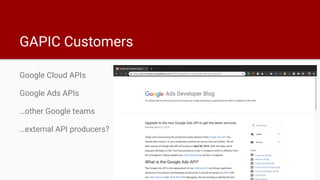

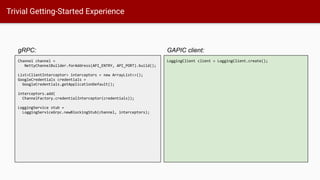


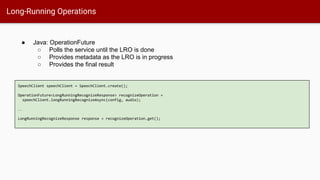

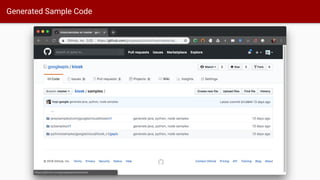







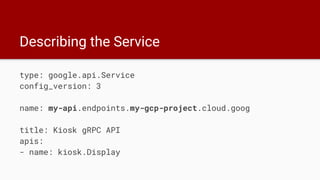


![$ export KIOSK_APIKEY=AIzaSy[...]bBo
$ k list kiosks
FROM localhost:8083 2018/09/21 19:08:25 Using API key: AIzaSy[...]bBo
LIST KIOSKS
id:1 name:"HTTP Kiosk" size:<width:1080 height:720 >
id:2 name:"HTTP Kiosk" size:<width:1080 height:720 >
Getting an API Key](https://image.slidesharecdn.com/creatinggreatrestandgrpcapiexperiencesinswift-190330042808/85/Creating-Great-REST-and-gRPC-API-Experiences-in-Swift-75-320.jpg)

![service Display {
rpc CreateKiosk(Kiosk) returns (Kiosk) {
option (google.api.http) = {post:"/v1/kiosks"};
}
rpc GetKiosk(GetKioskRequest) returns (Kiosk) {
option (google.api.http) =
{get: "/v1/kiosks/{id}" };
}
rpc DeleteKiosk(DeleteKioskRequest)
returns (google.protobuf.Empty) {
option (google.api.http) =
{ delete: "/v1/signs/{id}" };
}
[...]
}
Add REST annotations to your service
gRPC definitions with HTTP annotations
service Display {
rpc CreateKiosk(Kiosk) returns (Kiosk) {
}
rpc GetKiosk(GetKioskRequest) returns(Kiosk) {
}
rpc DeleteKiosk(DeleteKioskRequest)
returns (google.protobuf.Empty) {
}
[...]
}
gRPC definitions](https://image.slidesharecdn.com/creatinggreatrestandgrpcapiexperiencesinswift-190330042808/85/Creating-Great-REST-and-gRPC-API-Experiences-in-Swift-77-320.jpg)
![# Add a kiosk
$ curl -d '{"name":"HTTP Kiosk", "size": { width: 1080, height: 720 } }'
localhost:8082/v1/kiosks?key=AIzaSy[...]bBo
# Get kiosk
$ curl localhost:8082/v1/kiosks/1?key=AIzaSy[...]bBo
Now you can use HTTP+JSON!](https://image.slidesharecdn.com/creatinggreatrestandgrpcapiexperiencesinswift-190330042808/85/Creating-Great-REST-and-gRPC-API-Experiences-in-Swift-78-320.jpg)





